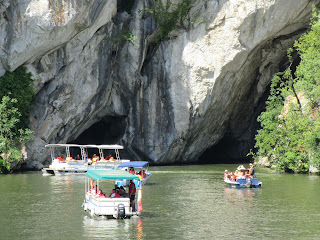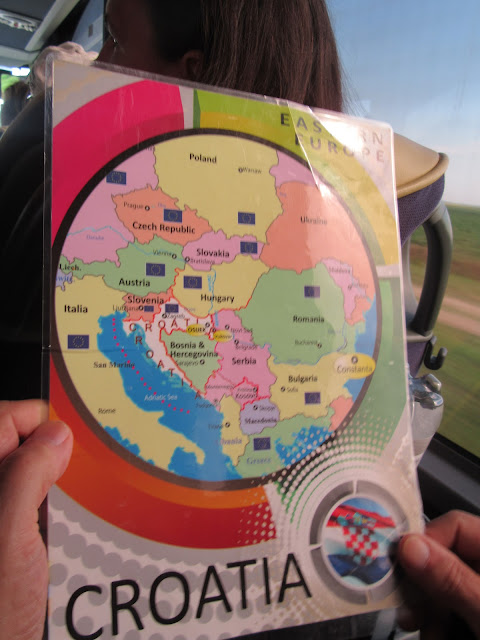So far, our only mishap had been when I bumped my eye brow into the glass shelf above the plug in kettle that I heated the water in for our cups of Nescafe instant, a common offering in European hotel rooms.
We took the elevator down to the opulent reception area, checked out and received our breakfast box. Since we did not need anything else to carry, we found a table and had our snack. We had a tomato and cheese sandwich, a little muffin, a piece of fruit, an energy bar, and 16 ounces of water. The bars and fruit went into the tote bag for later. We started the water. It is very important to stay hydrated when flying long distances.
Our big bus was in front of the Hilton a little before six.
The square in front of the hotel with all its old buildings was pretty much deserted in the early morning under the clear blue summer sky. It had been bustling with cars and people when we came in from dinner the night before.
Our Viking representative checked us off and found two were missing. She went back inside and soon returned. They had decided to extend a couple of days. I was wishing that we could, too, but we were packed and boarded and it was a little too late to back up.
h.
The bus moved quickly through the streets which had been clogged with traffic when we were on them Thursday. In less than half an hour, we were in front of the terminal where we claimed our bags and rolled them in to the departure area. I have decided that rolling luggage is one of the great inventions of the twentieth century. We scanned our passports in and the tickets printed out. Magic, once again! We then took the boarding passes, passports, and luggage to the line which moved quickly. Soon the bags were checked to Orlando and we were on the way to security.
Since Romania and France, our next stop are both in the European Union, our first flight was basically a domestic flight. We were on a small airline that partners with Air France. Since I have passed the magic birthday of 75, I did not have to remove my shoes. All our liquids were in a zip lock bag and we had put my laptop in a checked bag to speed things up. Now, security is likely to have you turn on all computers to prove that they are operational. Even though mine was charged up, I did not relish the extra time that it would take. Checking it also lightened the load in Klep's carryon, never a bad idea!
Before we entered the line, we finished off our water, reserving the empty containers just in case we found a convenient water fountain to refill them. We did not, by the way, so they were discarded during the flight.
We all managed to get through security though I think at least one of us got extra attention on a random check. We then retrieved all of our things, the men put their belts back on, the girls put their watches back on, and we stowed everything in its proper place until we went through it all again at Charles DE Gaulle and Atlanta. We managed to get checked on random checks again and once I sat off an alarm, I suppose from the little bit of titanium in my abdomen.
We watched the planes from our seats. When it neared flight time, all the locals got up and got into line before the flight was called. We didn't see a whole lot of reason to do this since we had seats, so we waited until most of them had loaded.
We were all toward the tail of the plane. There was an empty seat on my row and a row of empty seats behind Klep, Rob, and Traci. After we took off, he took advantage of the extra space to spread out and have more leg room.
The Tarom flight attendants served us a breakfast while we were in the air. The flight was relatively smooth with just a little turbulence as we passed over the Alps. Much of the time, we could look out the window and see the neat patches on land down below. There was snow on the alps when we flew over them.
I got out my mindless mystery I had started on the flight from Paris to Budapest and read more, determined to get it finished before I got home. Although the author managed to kill off most of the characters in the book, I did not finish until the day after I got home!
At Charles de Gaulle, we went through the marathon experience of moving into a distant terminal. After we got directions of how to do that without leaving the secure zone, we made the necessary toilet stop. My motto is never pass up a bathroom that is on the ground. That is where I was amused to find the lovely orange toilet seat.
On a long trip such as this, sometimes, you need to take time for a laugh or two!
After finding the terminal, clearing passports and security once again, we found our gate and collapsed into our seats. Our next flight we were flying premium economy which meant our boarding was easier and our seats more comfortable for the over six hours it took to fly across the Atlantic. It isn't quite first class, but it is close and we still got our cute little pouches with the sleep mask, socks, ear plugs, etc. in them. These were pretty and shinny. I think our grand daughters will like them. We also had a nice pillow and blanket, but we did not sleep. After I tired of my book, I watched a couple of movies. Air France served us dinner and a small meal before landing.
We cleared customs in Atlanta which meant we had to get our luggage, go through a line, and recheck the luggage. After my bag was rechecked, it was gone through by TSA and did not make the flight. I did not find out that they searched it until I unpacked after we got home and read the little notice they had put in the bottom of the bag.
Leaving Atlanta on Delta, we flew over a lot of thunderstorms which kept the fasten your seat belt sign on for the entire trip. It was really quite beautiful flying over the clouds at sunset. According to our piolet this picture was taken over the Valdosta area.
We were off the plane quickly in Orlando and hoofed it to baggage pick up. Everything came except for my bag which had my laptop in it. The woman at the lost baggage desk discovered that it was coming in on the next flight from Atlanta. I am going to assume that she had had a rough day, and that she really wasn't the type person who found being helpful important.
We held a family conference and it was decided that Traci and I would wait for the bag and the boys would go get the car. We parked ourselves in the waiting area between the doors and the baggage until the flight came in. We were outside waiting when the guys drove up and retrieved us. At this point, it had been twenty-four hours since our wake-up calls and we all needed sleep.
The day had been long, but we had made it safely and fairly sanely to our destination. The next day, we shared memories of our trip as we drove up the turnpike and I 75 to Mosquito Gardens.
We saw things and had experiences that we never thought we would. Once again, we marvel at what an interesting world God has given us to live in and that most of the people he has put in it are pretty nice, too!































 We passed farmland rolling away from the river and lots of settlements before arriving at the gorge that ran through the soaring peaks known as the Iron Gate of the Balkans.
We passed farmland rolling away from the river and lots of settlements before arriving at the gorge that ran through the soaring peaks known as the Iron Gate of the Balkans.

















